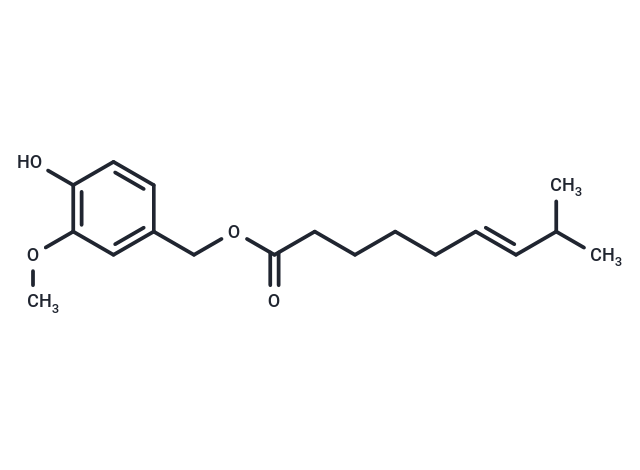Shopping Cart
- Remove All
 Your shopping cart is currently empty
Your shopping cart is currently empty
Capsiate is an orally active TRPV1 agonist, a non-irritating capsaicin analog that acts as an antiallergic agent with anti-inflammatory, antioxidant, hypoglycemic, and inhibitory angiogenic activity.

| Pack Size | Price | Availability | Quantity |
|---|---|---|---|
| 1 mg | $73 | In Stock | |
| 5 mg | $189 | In Stock | |
| 10 mg | $289 | In Stock |
| Description | Capsiate is an orally active TRPV1 agonist, a non-irritating capsaicin analog that acts as an antiallergic agent with anti-inflammatory, antioxidant, hypoglycemic, and inhibitory angiogenic activity. |
| Targets&IC50 | TRPV1:290 nM(EC50) |
| In vitro | Capsiate elicits current responses in HEK293 cells expressing TRPV1[3]. Additionally, Capsiate (5 to 25 µM) inhibits Src and VEGF-induced proliferation and tube formation in human umbilical vein endothelial cells (HUVECs)[1]. |
| In vivo | Capsiate (0.03~0.54 mM; s.c.) induces nociceptive responses in mice.[3] Topical application of Capsiate reduces antigen-induced increases in ear thickness in a mouse model of passive cutaneous anaphylaxis and decreases epidermal thickness and eosinophil and mast cell infiltration in a mouse model of atopic dermatitis.[3] Capsiate (10 mg/kg) decreases body weight gain and perirenal fat weight, as well as increases oxygen consumption, fat oxidation, and carbohydrate oxidation, in a mouse model of ad libitum feeding-induced weight gain.[4] |
| Molecular Weight | 306.4 |
| Formula | C18H26O4 |
| Cas No. | 205687-01-0 |
| Smiles | C(OC(CCCC/C=C/C(C)C)=O)C1=CC(OC)=C(O)C=C1 |
| Relative Density. | 1.053 g/cm3 |
| Storage | store at low temperature,keep away from direct sunlight,keep away from moisture | Pure form: -20°C for 3 years | In solvent: -80°C for 1 year | Shipping with blue ice/Shipping at ambient temperature. | |||||||||||||||||||||||||||||||||||
| Solubility Information | DMSO: 90 mg/mL (293.73 mM), Sonication is recommended. | |||||||||||||||||||||||||||||||||||
Solution Preparation Table | ||||||||||||||||||||||||||||||||||||
DMSO
| ||||||||||||||||||||||||||||||||||||

Copyright © 2015-2025 TargetMol Chemicals Inc. All Rights Reserved.